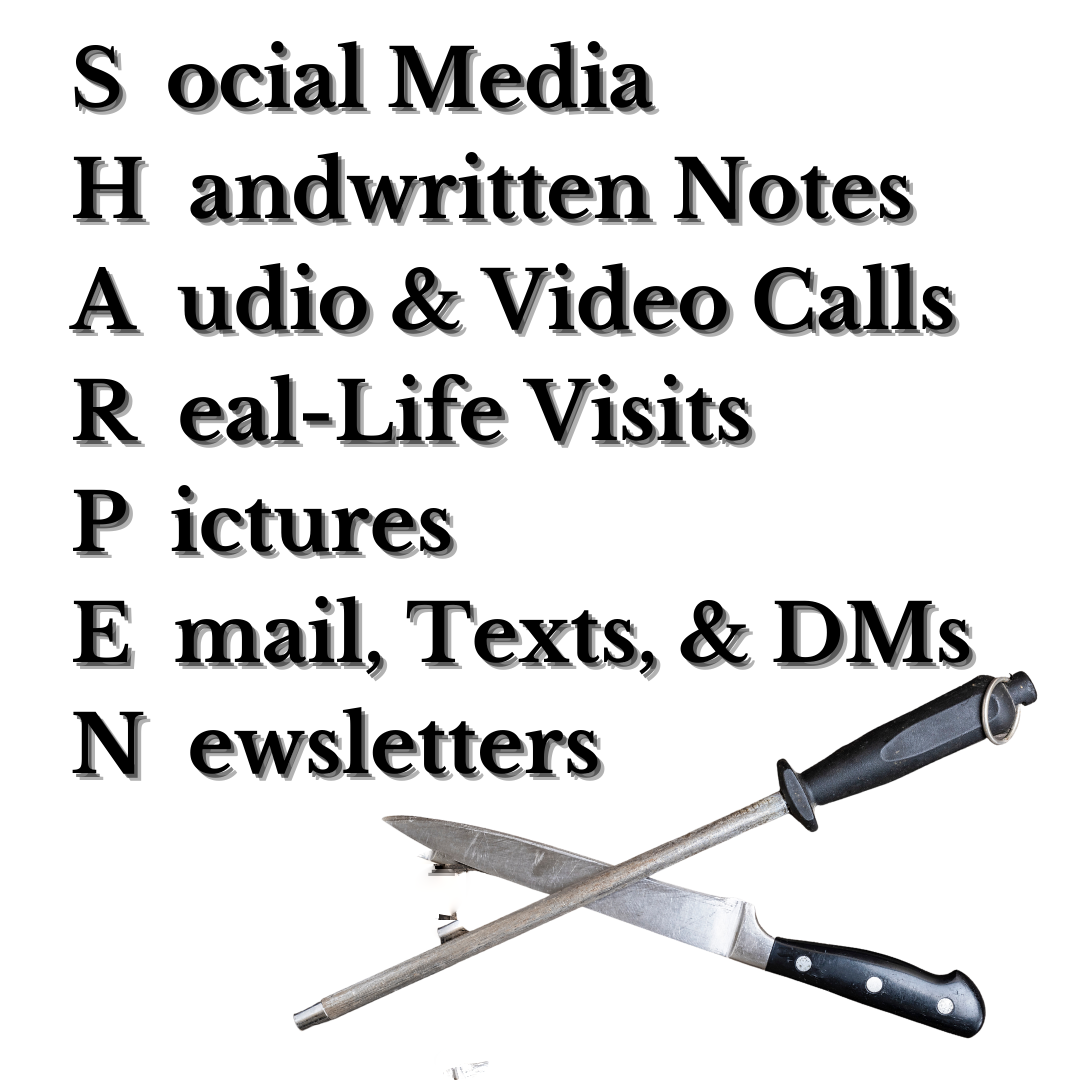Step 1: Listen to the Podcast
Step 2: Read the Devotional
Iron sharpens iron, and one man sharpens another.
Nothing can replace regular, quality communication with our Go-Team. Our team members are central to our network of financial and prayer support; quality communication is their connection to us and our mission field. These relationships are Biblical and mutually beneficial. Proverbs tells us that “Iron sharpens iron, and one man sharpens another.” (27:17) Communication between each of us SHARPENs and readies us for our God-given mission. The acronym SHARPEN will provide a reminder of the forms of communication we can regularly employ.
The acronym SHARPEN will provide a reminder of the forms of communication we can regularly employ.

Social Media We have to meet people where they are, and today that often means on platforms like Instagram, Twitter, Discord, Facebook, SnapChat, You-Tube, or the like. These may not be the forms of communication we prefer or with which we are most comfortable, but for many, especially Millennials and Gen-Zers, it is critical. Younger people rely on it because it is quick, informal, engaging and public. The ease of including videos, photos and links is another benefit. The down-side is that it is ever-changing, but an investment of effort to keep in-the-know will help us connect with our younger supporters. Today, one thing is for sure: excluding social media in communication is not an option.

Hand-written Notes The converse of social media is old-school, snail-mail. Handwritten cards and letters convey a warm, personal touch. A postcard is like a DM in hard copy. Recipients know it takes us time to sit down with pen and paper, and they usually appreciate the sacrifice and effort. Keep stamps on hand; pick up a few post cards as you travel; make the post office a regular stop in your route of errands. Many older supporters, in particular, will value it.
Audio and Video Calls There is an intimate connection through conversation. A human voice has personality and an audible texture that cannot be conveyed through writing. A phone call is relationship-building, and when we can engage through video calls, all the better. Be sure and ask your supporter what prayer needs they have.

Real-Life Visits Face-to-face meetings aren’t possible all the time, or for everyone, but when the opportunity presents itself we should take advantage of meetings IRL. Ask a supporter to join you for coffee. Offer to come by their home or church for an informal meeting. If a donor says, “Let’s get together the next time you’re in town,” take them at their word. Spend some time with them. When we give the gift of our time, a donor’s financial gifts and prayers mean even more.
Pictures Regularly send a updated, hard-copy photo of yourself and your family that can be displayed in your supporter’s home or office. It is memorable to include digital pictures in your online communication and posts, but there is no replacement for a printed photo in-hand. A picture display is a physical reminder that will prompt our supporters to pray for and give to our work.
Emails, Texts, DMs The type of communication that most of us have the easiest time keeping up with is digital. It is convenient and instantaneous, but it is a mistake to rely too heavily on it. Use DMs to include your Go-Team members in some of your ministry moments. Draft an email when communication must include more detail or business-like information. Be proactive with messages, but patient with replies. Use it in moderation; it is just one of several tools of communication.
Newsletters The staple of our communication toolbox is our newsletter. The newsletter is still vital, and it is still welcomed by most supporters. This is where we can give regular, general information about our ministry and personal life, including prayer requests and specific needs. An advantage to publishing regular newsletters is when we reach out via the other methods of communication supporters will already have background information for context. Remember, nothing will take the place of an updated, engaging newsletter. Your first reaction to these suggestions may be “I don’t have time to do all of that.” It is vital that we look at it from the opposite perspective: we can’t afford NOT to do it. If the apostle Paul could make time for communication with his supporters we can too. Cultivate this part of your ministry as an ambassadorship between your mission field and your Go-Team. When we spend time SHARPENing our communication skills we will better see their great value.

Step 3: Pray and Reflect
Now, how about you?
- In what way do you view the church as part of your mission field?
- What misconceptions might members of your Go-Team need to overcome?
- Craft a specific response that you can use to correct at least one of these misconceptions.Commit to speaking truth boldly to fellow Christians so that more of the Lost can hear the Gospel and be discipled into full maturity in Christ.